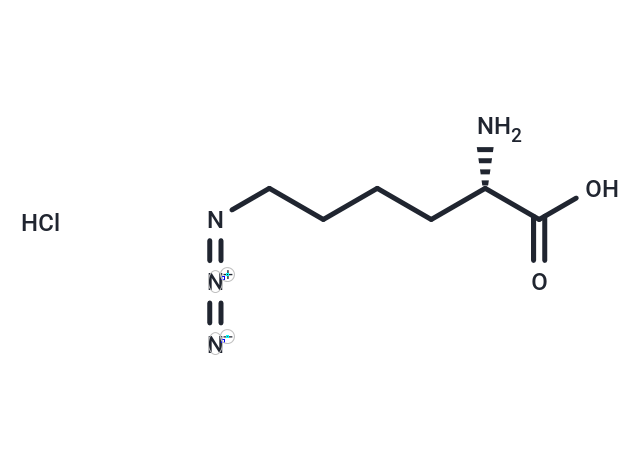Shopping Cart
- Remove All
 Your shopping cart is currently empty
Your shopping cart is currently empty

L-Azidonorleucine hydrochloride, an unnatural amino acid, serves as a substitute for Methionine, and is used for labeling mammalian cell proteins and identifying various methionyl-tRNA synthetase (MetRS) mutants.

| Pack Size | Price | Availability | Quantity |
|---|---|---|---|
| 2 mg | $31 | 5 days |
| Description | L-Azidonorleucine hydrochloride, an unnatural amino acid, serves as a substitute for Methionine, and is used for labeling mammalian cell proteins and identifying various methionyl-tRNA synthetase (MetRS) mutants. |
| In vitro | CHO cells transfected with pMaRSC and incubated with L-Azidonorleucine (Anl; 1.5 mM; 6 h) are fixed, permeabilized, and treated with alkyne-TAMRA. The TAMRA fluorescence is observed exclusively in mCherry-expressing cells, indicating selective incorporation of Anl into cellular proteins[1]. |
| In vivo | When administering L-Azidonorleucine (ANL) through drinking water, it is recommended to maintain an intake of 0.9 mg/day/g body weight for 21 days to label specific brain neuronal populations. For other cell types, reduced dosages or shorter labeling durations may suffice. Alternatively, for intraperitoneal (i.p.) injection, exploring dosages between 4-400 mM is advised. Specifically, a 400 mM dose administered i.p. (10 ml/kg volume) daily for a week effectively labels certain neuronal populations, like the excitatory neurons in the hippocampus, whereas lower concentrations (e.g., 4 mM) are suitable for labeling different cell types or for extended labeling periods[2]. |
| Molecular Weight | 208.646 |
| Formula | C6H13ClN4O2 |
| Cas No. | 1454334-76-9 |
| Relative Density. | no data available |
| Storage | Powder: -20°C for 3 years | In solvent: -80°C for 1 year | Shipping with blue ice. |

Copyright © 2015-2025 TargetMol Chemicals Inc. All Rights Reserved.